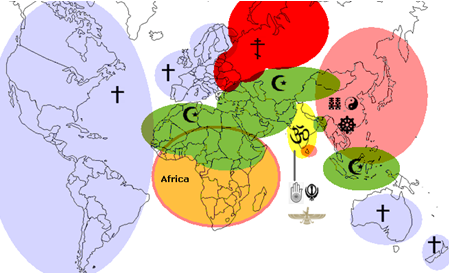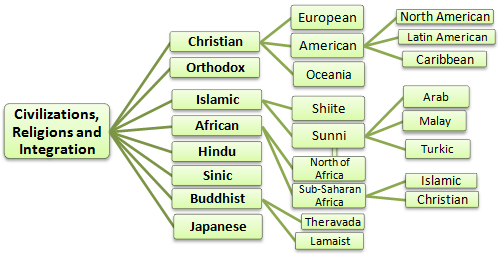World Economic Areas
World Economic Areas. Civilizations, Religions, and Economic Integration. Master / Doctorate in International Business
The module “World Economic Areas” is part of the following Online Programs taught by EENI Global Business School:
Master in International Business
The main objective of this module of the Master / Doctorate in International Business is to know the state of the World: trade blocs, trends in regional economic integration, emerging countries (BRICS), or the African continent emergence.
EENI has developed a unique analysis methodology of the State of the World based on the concept of “Civilizations, Religions, and Regional Economic Integration.” Despite the globalization phenomenon, business also tends to regionalization.

Analysing the role of the civilizations - religions in a globalized world; we can identify eight major economic-religious areas, each area, can be formed by one or more distinct economic areas.

Optional subjects that the student can select:
- Introduction to Civilizations, religions, and regional economic integration [1]
- Islamic Economic Area [4]
- Economic Area of the Western Civilization [9]
- Hindu Economic Area [2]
- Sinic Economic Area [2]
- Buddhist Economic Area [2]
- Orthodox Economic Area [2]


Christianity (Catholicism and Protestantism) is the largest religion. In the Western Civilization, we can identify three different economic areas:
- American Economic Area, divided in the North American Economic Area (with the U.S. as the Central State), the Latin American Economic Area (Brazil -BRICS country- as the Central State) and the Caribbean Economic Area
- European Economic Area, with Germany as the Central State
- Economic Area of Oceania

Islam (Sunni and Shiite) is the largest religion. In the Islamic Civilization, we can identify five different economic areas.
- Arab Economic Area, with Saudi Arabia as the Central State
- Central Eurasian Economic Area. Turkey, Iran, and Pakistan are competing to be the central state
- Malay Economic Area, formed by the ASEAN Muslim Countries
- Maghrebian Economic Area (shared with the African Civilization)
- African Economic Area (belonging to the African Civilization)
Islam and Christianity (besides African Traditional Religions) are the main religions in Africa. Nigeria and/or South Africa (a BRICS country) are the Central States. In the African Civilization, we can identify five different economic areas:
- West African Economic Area
- Central African Economic Area
- Southern African Economic Area
- East African Economic Area
- Maghrebian Economic Area (Islamic Civilization)

Hinduism is the largest religion; Bharat is the central state and a BRICS country.

Buddhism, Confucianism, and Taoism are the main religions. China (a BRICS country) is the Central State. The area of influence of this Economic Area includes Vietnam, South Korea, Taiwan, and Singapore.

6- Buddhist Economic Area, where Buddhism (Mahayana, Theravada) is the main religion. This economic area consists of Burma, Cambodia, Laos, Sri Lanka, and Thailand. In some countries, it coincides with the Sinic Economic Area.
7-Orthodox Economic Area, where Orthodox Christianity is the main religion. Russia (a BRICS country) is the Central State. This economic area includes Armenia, Belarus, Georgia, or Serbia.

8- Japanese Civilization. Japan is the only country of this civilization.
For each of these eighteen economic areas; we will analyze:
- Characteristics of each economic area
- Economic Profile of the largest markets
- Economic integration processes
- Principles, ethical basis and its relationship with business of each religion
- Regional Economic Organizations
- Businesspeople Profiles
- Interactions with the other economic areas (trade agreements)
It is important to note that due to the introductory character of this module, for each of these included topics (organizations, religions, Businesspeople, Free Trade Agreements...) we will introduce only a summary of each of them, the in-depth analysis of each of them is done in other master and/or doctoral programs.
For example, the SAARC is an agreement between three civilizations - Buddhist, Hindu, and Islamic; the summary of the SAARC in this module is approximately 3 pages, while the detailed analysis is 56 pages.
This new approach to study the economic relations between the civilizations will help the students to understand better the state of the World.

Master in International Business: Globalization, World Economic Areas, Foreign Trade, Transportation, Global Marketing, Adaptation to the country of the student (Africa, Asia, Middle East, Europe), Thesis, Career Opportunities.
 Master Negocios Internacionales
Master Negocios Internacionales  Master en affaires internationales
Master en affaires internationales  Mestrado em Negócios Internacionais.
Mestrado em Negócios Internacionais.
(c) EENI Global Business School (1995-2024)
We do not use cookies
Top of this page



